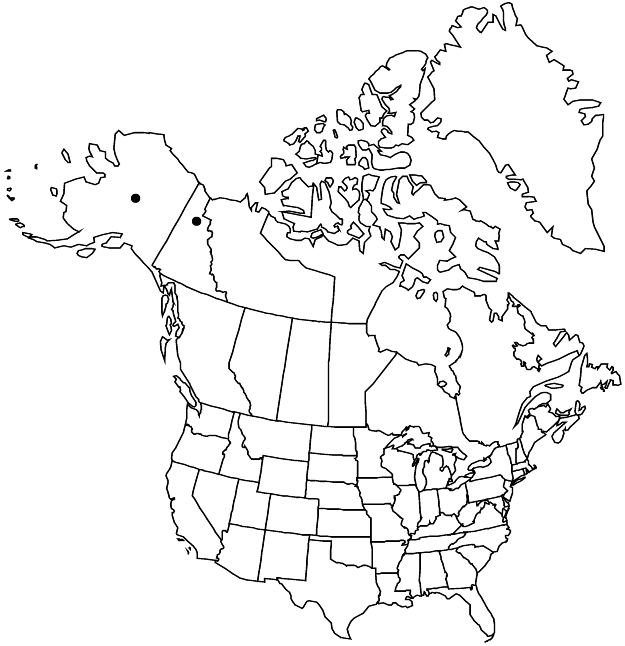Difference between revisions of "Stellaria dicranoides"
in C. F. von Ledebour, Fl. Ross. 1: 395. 1842.
FNA>Volume Importer |
FNA>Volume Importer |
||
| Line 15: | Line 15: | ||
|name=Arenaria chamissonis | |name=Arenaria chamissonis | ||
|authority=Maguire | |authority=Maguire | ||
| − | }}{{Treatment/ID/Synonym | + | }} {{Treatment/ID/Synonym |
|name=Arenaria dicranoides | |name=Arenaria dicranoides | ||
|authority=(Chamisso & Schlechtendal) Hultén | |authority=(Chamisso & Schlechtendal) Hultén | ||
| Line 33: | Line 33: | ||
|elevation=300-1700 m | |elevation=300-1700 m | ||
|distribution=Yukon;Alaska;Asia (Russian Far East). | |distribution=Yukon;Alaska;Asia (Russian Far East). | ||
| − | |discussion=<p>Stellaria dicranoides is of uncertain generic position. Many workers have placed it in the genus Arenaria. The absence of petals deprives us of a key character separating Stellaria from Arenaria. The ovate capsule with its three valves, each tardily dehiscent into two, suggests Arenaria or Minuartia. However, the chromosome number of 2n = 26 is more often associated with Stellaria. The single large seed, which fills the capsule, is unusual. In its floral structure, including its large nectaries and unisexual flowers, S. dicranoides closely resembles the European M. (Cherleria) sedoides (Linnaeus) Hiern. In fact, Chamisso, who first described this species, placed it in the genus Cherleria.</p> | + | |discussion=<p><i>Stellaria dicranoides</i> is of uncertain generic position. Many workers have placed it in the genus <i>Arenaria</i>. The absence of petals deprives us of a key character separating <i>Stellaria</i> from <i>Arenaria</i>. The ovate capsule with its three valves, each tardily dehiscent into two, suggests <i>Arenaria</i> or <i>Minuartia</i>. However, the chromosome number of 2n = 26 is more often associated with <i>Stellaria</i>. The single large seed, which fills the capsule, is unusual. In its floral structure, including its large nectaries and unisexual flowers, <i>S. dicranoides</i> closely resembles the European M. (Cherleria) sedoides (Linnaeus) Hiern. In fact, Chamisso, who first described this species, placed it in the genus Cherleria.</p> |
|tables= | |tables= | ||
|references= | |references= | ||
| Line 57: | Line 57: | ||
|publication year=1842 | |publication year=1842 | ||
|special status= | |special status= | ||
| − | |source xml=https://jpend@bitbucket.org/aafc-mbb/fna-data-curation.git/src/ | + | |source xml=https://jpend@bitbucket.org/aafc-mbb/fna-data-curation.git/src/8f726806613d60c220dc4493de13607dd3150896/coarse_grained_fna_xml/V5/V5_216.xml |
|subfamily=Caryophyllaceae subfam. Alsinoideae | |subfamily=Caryophyllaceae subfam. Alsinoideae | ||
|genus=Stellaria | |genus=Stellaria | ||
Revision as of 18:37, 18 September 2019
Plants perennial, dioecious, forming dense cushions to 10 cm or more diam., with branching caudex, arising from taproot. Stems branched, 4-angled, 1–4 cm, glabrous; branches erect or ascending, thickly clothed with marcescent leaves. Leaves sessile; basal blades oblanceolate to obovate or elliptic, 3–5 × 1–1.5 mm, succulent, base cuneate, margins entire, apex acute or abruptly acuminate to obtuse, glabrous; cauline shorter. Inflorescences solitary-flowered in axils of foliage leaves; bract 1, foliaceous, ca. 1 mm. Pedicels 1–5 mm, glabrous. Flowers unisexual, 3–4 mm diam.; sepals 5, 3-veined, keeled, 2.5–3 mm, margins narrow, apex acute, glabrous or with sparse, short, glandular pubescence; petals absent; stamens 10, shorter than sepals; styles 3, erect, becoming outwardly curved, ca. 1 mm; staminate flowers with brownish, peglike, conspicuous nectaries alternating with and attached to base of stamens; pistillate flowers with well-developed but nonfunctional stamens and nectaries. Capsules straw colored, broadly ovoid, ca. 3 × 2 mm, ca. equaling sepals, apex obtuse, opening by 3 valves, each of which splits into 2; carpophore absent. Seeds 1, brown, broadly reniform with thickened rim, ca. 1.1 mm diam., finely verrucate. 2n = 26.
Phenology: Flowering summer.
Habitat: Arctic screes, fellfields, gravelly tundra, rocky knolls on wide variety of rock types
Elevation: 300-1700 m
Distribution

Yukon, Alaska, Asia (Russian Far East).
Discussion
Stellaria dicranoides is of uncertain generic position. Many workers have placed it in the genus Arenaria. The absence of petals deprives us of a key character separating Stellaria from Arenaria. The ovate capsule with its three valves, each tardily dehiscent into two, suggests Arenaria or Minuartia. However, the chromosome number of 2n = 26 is more often associated with Stellaria. The single large seed, which fills the capsule, is unusual. In its floral structure, including its large nectaries and unisexual flowers, S. dicranoides closely resembles the European M. (Cherleria) sedoides (Linnaeus) Hiern. In fact, Chamisso, who first described this species, placed it in the genus Cherleria.
Selected References
None.